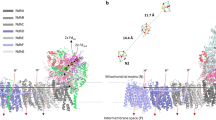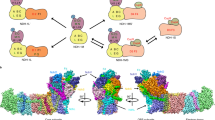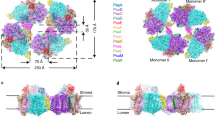Abstract
In many cyanobacteria and algae, cytochrome c6 transports electrons between the cytochrome bf complex and photosystem I, replacing plastocyanin when copper is deficient. Higher plants, however, were thought to lack cytochrome c6 (refs 1,2) until the existence of a modified form in several species was inferred from genomic evidence3. By measuring oxygen evolution with inside-out thylakoids, Gupta et al. inferred that heterologously expressed Arabidopsis cytochrome c6 can replace plastocyanin from Synechocystis or Arabidopsis in reconstitution experiments in vitro4. From structural and kinetic evidence, however, we find that Arabidopsis cytochrome c6 cannot carry out the same function as Arabidopsis plastocyanin or as cytochrome c6 from the alga Monoraphidium braunii. This suggests that cytochrome c6 in higher plants may have lost its original primitive function in photosynthesis.
This is a preview of subscription content, access via your institution
Access options
Subscribe to this journal
Receive 51 print issues and online access
$199.00 per year
only $3.90 per issue
Buy this article
- Purchase on Springer Link
- Instant access to full article PDF
Prices may be subject to local taxes which are calculated during checkout


Similar content being viewed by others
References
Hope, A. B. Biochim. Biophys. Acta 1456, 5–26 (2000).
De la Rosa, M. A. et al. Bioelectrochemistry 55, 41–45 (2002).
Wastl, J., Bendall, D. S. & Howe, C. J. Trends Plant Sci. 7, 244–245 (2002).
Gupta, R., He, Z. & Luan, S. Nature 417, 567–571 (2002).
Metzger, S. U., Pakrasi, H. B. & Whitmarsh, J. in Photosynthesis: From Light to Biosphere Vol. 2 (ed. Mathis, P.) 823–826 (Kluwer Academic, Dordrecht, The Netherlands, 1995).
Hervás, M., Navarro, J. A., Díaz, A., Bottin, H. & De la Rosa, M. A. Biochemistry 34, 11321–11326 (1995).
Navarro, J. A., Hervás, M. & De la Rosa, M. A. J. Biol. Inorg. Chem. 2, 11–22 (1997).
Author information
Authors and Affiliations
Corresponding author
Rights and permissions
About this article
Cite this article
Molina-Heredia, F., Wastl, J., Navarro, J. et al. A new function for an old cytochrome?. Nature 424, 33–34 (2003). https://doi.org/10.1038/424033b
Issue Date:
DOI: https://doi.org/10.1038/424033b
This article is cited by
-
Near-infrared in vitro measurements of photosystem I cofactors and electron-transfer partners with a recently developed spectrophotometer
Photosynthesis Research (2019)
-
Photosynthetic fuel for heterologous enzymes: the role of electron carrier proteins
Photosynthesis Research (2017)
-
In vitro kinetics of P700 + reduction of Thermosynechococcus elongatus trimeric Photosystem I complexes by recombinant cytochrome c 6 using a Joliot-type LED spectrophotometer
Photosynthesis Research (2017)
-
Derek Bendall (1930–2014)
Photosynthesis Research (2015)
-
Cytochrome c 6-like protein as a putative donor of electrons to photosystem I in the cyanobacterium Nostoc sp. PCC 7119
Photosynthesis Research (2011)
Comments
By submitting a comment you agree to abide by our Terms and Community Guidelines. If you find something abusive or that does not comply with our terms or guidelines please flag it as inappropriate.



